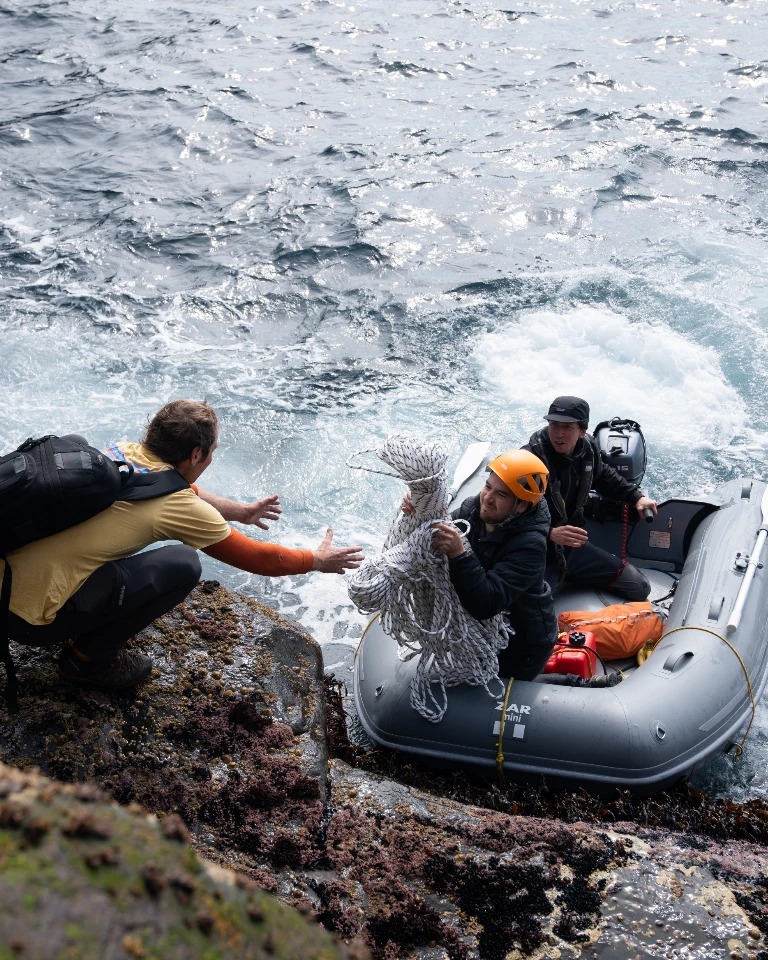The bubbling froth of the Atlantic waters rips ferociously past the Hebridean islands. The waters get funnelled through the channels, and with each turn of the tide, there is either opportunity or adversity. Which one it is depends on whether you’re going with or fighting against the tide. My sphere of knowledge is effectively zero when it comes to sailing. With hidden rocks and ripping currents scattered throughout the Scottish coastline, the fate of all onboard was down to @yachting_scotland .
Our team of 5 sailed aboard Somerled, a French-built racing boat which was cannily skippered by scott, who is without a doubt a modern-day Shackleton in the making. We were in safe hands during our passage to the edge of the British Isles. Life at 75 degrees, cocked to one side, thrashing through large bow waves at first feels intrusive, but the metrics of normal life shift rapidly. It’s surprising how quickly one can adjust to a new normal. I say ‘we’, but Robbie, who was suffering from seasickness the whole time, may have had an alternative viewpoint on that statement. It goes to show how psyched Robbie is on climbing; he’s willing to be sick for days to go climb a few new routes.
To be fair, the routes Robbie wanted to climb had the potential to be some of the most outrageous in the UK. Having to cross over 100 miles of ocean to access the inaccessible and uninhabited island of Soay would present its own challenges and dangers without even climbing a single meter of rock. And the rock in question is a breathtakingly huge and overhanging wall thrusting out over the sea.
Soay –
I’ve heard it said that the sea is a lung of the earth. Watching the sea swell rise and then fall against the rocks, the same rocks that form the island of Soay, it felt as if the sea was alive but sleeping for now.
There is no mooring point nor anchorage around Soay. The only way our team would get to the foot of the behemoth wall we wanted to climb was by leaving the yacht Somerled adrift in an evasive manoeuvre pointing out to sea. Three of us would cram in the inflatable and motorized dinghy with as much gear as we could safely fit. Our expert skipper, Scott, would command the inflatable to the most suitable point of contact with the island where we could jump from the dinghy to the rocks.
When the sea breathes out, the dinghy drops 2 meters. When the sea breathes in, it rises. The space between out and in is anywhere from 30 seconds to 60 seconds. It is upon this high point of the swell that a member of the crew must jump. There is little time to hesitate, there is perhaps a few seconds before the sea starts to drop again. If any member falls in, it could lead to catastrophic injuries as the sea would grate the person up and down the barnacle-covered rocks. Scott, who watches the sea, calls to whoever is about to jump, “Wait, wait, wait, NOW.” On the “now,” you jump. Once one person is on the rocks, thousands of pounds of camera and climbing equipment is thrown between dinghy and island using the same method. Then the second person jumps to the land. Now the dynamic shifts slightly as the process is repeated, but this time there is nobody on board Somerled. The boat is left drifting in the sea as we make haste to quickly offload the remaining gear and ourselves, but not so fast as to take a swim. Scott then returns to his companion, Somerled.
With no phone signal, the only contact we have with each other is via radio, but that only works when we can see each other. We arrange an ETA when Scott will return to the area and hopefully, get us off!

